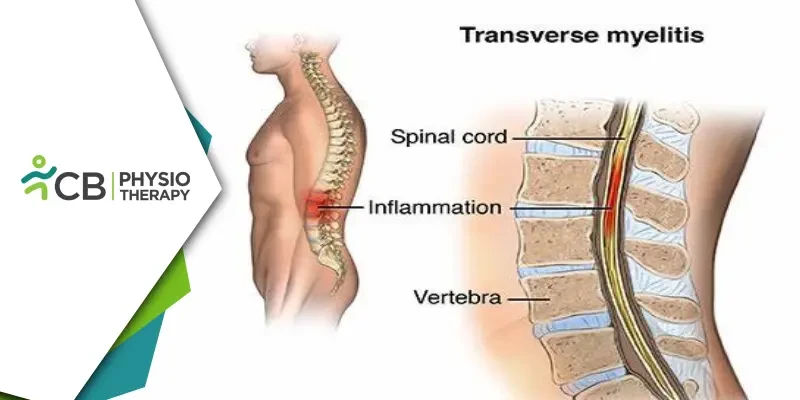Transverse Myelitis (TM) is a rare neurological disorder that affects the spinal cord, causing inflammation and damage to the myelin sheath—a protective covering of nerve fibers. It typically involves damage to the spinal cord, which is composed of both upper motor neurons (UMNs) and lower motor neurons (LMNs). However, Transverse Myelitis is primarily considered a disorder affecting upper motor neurons. This condition can lead to a range of debilitating symptoms, including weakness, numbness, and sometimes paralysis in various parts of the body. Coping with the challenges posed by Transverse Myelitis requires a comprehensive approach, and one essential component of the management strategy is physiotherapy. In this blog post, we will explore the intricacies of Transverse Myelitis and delve into the vital role that physiotherapy plays in its treatment and rehabilitation.
Understanding Transverse Myelitis
Transverse Myelitis is characterized by inflammation across both sides of one section of the spinal cord. This inflammation can interrupt the normal communication between the nerves in the spinal cord and the rest of the body, leading to a variety of symptoms. While the exact cause of Transverse Myelitis is often unclear, it is believed to result from an autoimmune response where the body's immune system mistakenly attacks its own tissues.The symptoms of Transverse Myelitis can develop rapidly and may include weakness, numbness, and a tingling sensation in the affected areas. Additionally, individuals with TM may experience pain, muscle spasms, and problems with bowel and bladder function. The severity and progression of these symptoms can vary widely from person to person, making the management of TM a complex and individualized process.
Role of Physiotherapy in Transverse Myelitis Management
Physiotherapy plays a crucial role in the holistic management of Transverse Myelitis, addressing both the immediate symptoms and the long-term impact on an individual's quality of life. The goals of physiotherapy in TM management include:1: Improving Mobility and Functionality: Physiotherapists work closely with individuals with Transverse Myelitis to enhance their mobility and functional abilities. This may involve a combination of exercises, stretching routines, and mobility training tailored to the specific needs and limitations of the individual.
2: Preventing Complications: Immobility can lead to a range of complications, including joint stiffness, muscle atrophy, and pressure sores. Physiotherapy aims to mitigate these risks by promoting movement, proper positioning, and skin care.
3: Strengthening Muscles: Weakness is a common symptom in TM, and physiotherapy is instrumental in addressing muscle weakness through targeted strength training exercises. Strengthening the muscles helps individuals regain control over their movements and improves overall stability.
4: Managing Pain: Physiotherapists employ various techniques to alleviate pain associated with Transverse Myelitis. This may include manual therapy, stretching, and the use of modalities such as heat or cold therapy, TENS, etc.
5: Enhancing Balance and Coordination: TM can impact balance and coordination, increasing the risk of falls. Physiotherapy interventions focus on improving these aspects to enhance the individual's overall safety and independence.
6: Adapting to Assistive Devices: In cases where mobility is severely affected, physiotherapists assist individuals in adapting to and effectively using assistive devices such as walkers, wheelchairs, or braces.
7: Promoting Respiratory Function: Transverse Myelitis can affect the respiratory muscles, leading to breathing difficulties. Physiotherapists employ respiratory exercises to improve lung function and promote optimal respiratory health.
8: Optimizing Neurological Recovery: Physiotherapy interventions are designed not only to address the physical aspects of Transverse Myelitis but also to optimize neurological recovery. This may involve neurorehabilitation techniques aimed at retraining the nervous system.
Tailoring Physiotherapy to Individual Needs
One of the strengths of physiotherapy in Transverse Myelitis management lies in its ability to adapt to the unique needs and challenges of each individual. Physiotherapists conduct thorough assessments to understand the specific impact of TM on the individual's body and design personalized rehabilitation programs accordingly.The rehabilitation process is often divided into different phases, starting with acute care and progressing to the long-term management of symptoms. In the acute phase, the focus may be on pain management, preventing complications, and initiating gentle movements. As the individual progresses, the emphasis shifts towards more intensive exercises to improve strength, flexibility, and overall function.
Beyond the physical aspects, physiotherapy also addresses the psychological and emotional well-being of individuals with Transverse Myelitis. Coping with a neurological disorder can be challenging, and physiotherapists often provide emotional support and motivation to help individuals navigate the emotional aspects of their journey.
Challenges and Opportunities
While physiotherapy plays a vital role in Transverse Myelitis management, there are challenges that individuals and healthcare professionals may face. Moreover, the long-term nature of TM often requires ongoing rehabilitation, making consistent access to physiotherapy services crucial for sustained improvement.Transverse Myelitis poses significant challenges, but with a multidisciplinary approach that includes physiotherapy, individuals can achieve improved mobility, functionality, and overall well-being. Physiotherapists play a pivotal role in guiding individuals through the various stages of Transverse Myelitis, providing not only physical rehabilitation but also emotional support and motivation.
As research continues to expand our understanding of Transverse Myelitis and its management, the role of physiotherapy will likely evolve, offering new insights and innovative approaches to enhance the quality of life for those affected by this neurological condition. In the journey towards recovery, physiotherapy stands as a beacon of hope, empowering individuals with Transverse Myelitis to regain control over their lives and embrace a future filled with possibilities.

